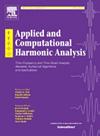Sharp error estimates for target measure diffusion maps with applications to the committor problem
IF 3.2
2区 数学
Q1 MATHEMATICS, APPLIED
引用次数: 0
Abstract
We obtain asymptotically sharp error estimates for the consistency error of the Target Measure Diffusion map (TMDmap) (Banisch et al. 2020), a variant of diffusion maps featuring importance sampling and hence allowing input data drawn from an arbitrary density. The derived error estimates include the bias error and the variance error. The resulting convergence rates are consistent with the approximation theory of graph Laplacians. The key novelty of our results lies in the explicit quantification of all the prefactors on leading-order terms. We also prove an error estimate for solutions of Dirichlet BVPs obtained using TMDmap, showing that the solution error is controlled by consistency error. We use these results to study an important application of TMDmap in the analysis of rare events in systems governed by overdamped Langevin dynamics using the framework of transition path theory (TPT). The cornerstone ingredient of TPT is the solution of the committor problem, a boundary value problem for the backward Kolmogorov PDE. Remarkably, we find that the TMDmap algorithm is particularly suited as a meshless solver to the committor problem due to the cancellation of several error terms in the prefactor formula. Furthermore, significant improvements in bias and variance errors occur when using a quasi-uniform sampling density. Our numerical experiments show that these improvements in accuracy are realizable in practice when using δ-nets as spatially uniform inputs to the TMDmap algorithm.
针对提交者问题的应用程序的目标度量扩散映射的精确误差估计
我们获得了目标测量扩散图(TMDmap)一致性误差的渐近尖锐误差估计(Banisch et al. 2020),这是扩散图的一种变体,具有重要采样功能,因此允许从任意密度提取输入数据。得到的误差估计包括偏置误差和方差误差。所得的收敛速率符合图拉普拉斯算子的近似理论。我们的结果的关键新颖之处在于对所有导序项上的前因子的显式量化。我们还证明了用TMDmap得到的Dirichlet bvp解的误差估计,表明解的误差是由一致性误差控制的。我们利用这些结果研究了TMDmap在利用过渡路径理论(TPT)框架分析由过阻尼朗格万动力学控制的系统中的罕见事件中的重要应用。TPT的基石是解决提交者问题,即后向Kolmogorov PDE的边值问题。值得注意的是,我们发现TMDmap算法特别适合作为提交问题的无网格求解器,因为它取消了前因子公式中的几个误差项。此外,当使用准均匀采样密度时,偏差和方差误差会得到显著改善。我们的数值实验表明,当使用δ-nets作为空间均匀输入到TMDmap算法时,这些精度的提高在实践中是可以实现的。
本文章由计算机程序翻译,如有差异,请以英文原文为准。
求助全文
约1分钟内获得全文
求助全文
来源期刊

Applied and Computational Harmonic Analysis
物理-物理:数学物理
CiteScore
5.40
自引率
4.00%
发文量
67
审稿时长
22.9 weeks
期刊介绍:
Applied and Computational Harmonic Analysis (ACHA) is an interdisciplinary journal that publishes high-quality papers in all areas of mathematical sciences related to the applied and computational aspects of harmonic analysis, with special emphasis on innovative theoretical development, methods, and algorithms, for information processing, manipulation, understanding, and so forth. The objectives of the journal are to chronicle the important publications in the rapidly growing field of data representation and analysis, to stimulate research in relevant interdisciplinary areas, and to provide a common link among mathematical, physical, and life scientists, as well as engineers.
 求助内容:
求助内容: 应助结果提醒方式:
应助结果提醒方式:


